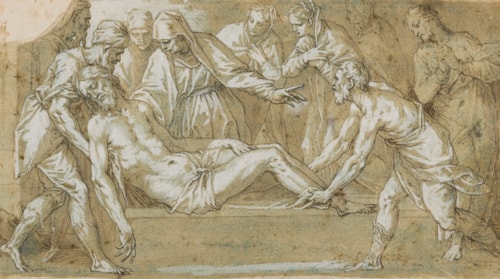
Johann (Hans) ROTTENHAMMER
Munich 1564 - Augsburg 1625
Biography
The son of the master of the Imperial stables at the Bavarian court in Munich, Johann (or Hans) Rottenhammer received his artistic training in the 1580s from the court painter Hans Donauer. In 1588 he undertook a trip to Italy, where he was to remain until 1606. After a period in Treviso, where he may have worked with the Flemish artist Lodewijk Toeput, known as Pozzoserrato, Rottenhammer settled in Venice for a few years. In 1594 he went to Rome, but by the fall of the following year was back in Venice. He spent the next ten years in Venice, marrying a local woman and establishing a successful career as a painter of small-scale mythological and religious scenes, usually on copper, some of which may have been intended to be inlaid into furniture. He also collaborated on paintings with the landscape artist Paul Bril, painting figures on small copper panels which would then be sent to Bril in Rome, who would add landscape elements to complete the compositions. (Rottenhammer likewise collaborated in this way with Jan Brueghel the Elder, when both artists were working in Rome, and later with the young Adam Elsheimer in Venice.) Like Bril and Brueghel, Rottenhammer was one of a group of Northern painters who enjoyed the patronage of Cardinal Federico Borromeo in Rome in the first half of the 1590s, and he continued to maintain close contact with the Cardinal after his return to Venice. Accepted into the Venetian painter’s guild in 1603, Rottenhammer travelled widely throughout Northern Italy, and received commissions from, among others, Ferdinando Gonzaga, Duke of Mantua, and the Emperor Rudolf II in Prague, for whom he painted a Feast of the Gods and also acted as a buying agent. Many of his painted compositions were also reproduced as engravings by printmakers such as Lucas Kilian and Raphael Sadeler the Elder, and his studio in Venice was frequented by German artists visiting the city.
In 1606 Rottenhammer returned to Germany, settling in Augsburg and painting several altarpieces for churches there and in Munich. In 1609 he was commissioned by Count Ernst von Scharmburg to paint the Goldener Saal of the Schloss Bückeburg, near Hannover. He was also active as a fresco painter in Augsburg, decorating the facade of the Hopfer house there in 1611. Other commissions included paintings for the ducal palace in Munich, completed in 1616, and the town hall of Augsburg. Apart from these large-scale public projects, Rottenhammer continued to paint small cabinet pictures of mythological subjects, often on copper; works which remained popular with collectors well into the 18th century. Although very successful, he suffered from alcoholism and frequent illnesses, and was often unable to work to deadlines or complete commissions in the agreed time. Nevertheless, the extent of his reputation throughout the Holy Roman Empire meant that many artists came to study with him, and his position as the leading painter in Augsburg remained secure until his death in 1625.
As has been noted, ‘Hans Rottenhammer ranks among the most interesting draughtsmen in German art around 1600’, and the artist’s drawings have long been admired, although only around a hundred sheets are known today. He drew intensively from the start of his independent career, and through his upbringing at the court in Munich – where artists such as Friedrich Sustris and Peter Candid, both of whom had earlier lived and worked in Florence, were active – he was exposed to the Italian tradition of draughtsmanship from an early age. During his own time in Italy Rottenhammer immersed himself in the drawing practices of local artists in Venice and Rome. Several of his drawings were reproduced by printmakers such as the Sadeler family, Jacob Matham and Crispin van de Passe, and by around 1600 it seems that his drawings were already being collected by connoisseurs. As Thomas DaCosta Kaufmann and Heiner Borggrefe write, ‘Rottenhammer considered drawing to be a central part of his artistic work. His drawings show him to be a confident artist in constant progress and transformation. Inspired...by his fundamental experiences in Venice and Rome, Rottenhammer can be regarded as the prime example of an artist travelling to Italy from the north, who does not merely imitate the canon of Italian models, but rather permeates it and condenses it into something new. His path proves him to be a curious, sensitive and productive artist who succeeded in creating an independent oeuvre from the various currents he encountered in Italy.’


